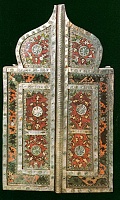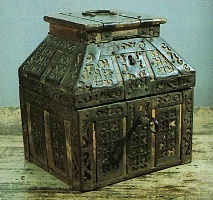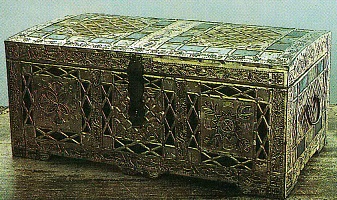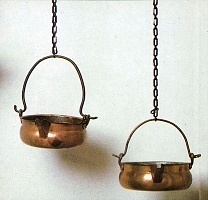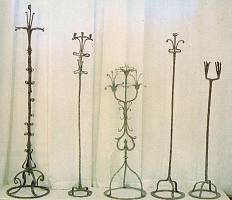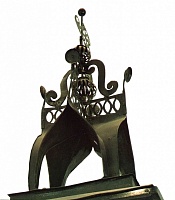The 17th – 19th Century Artistic Metalwork
Even such a simply-looking material as tin, was differently used in the 16th – 17th century Russian art. Its softness permitted to use it for plaques with all possible floral patterns that framed the panels of wooden chests, decorated mirrors, icon-cases, church lanterns, etc. The most rare exhibit is the 17th century three-folded mirror decorated with open work tin and slots covered with bright painting and mica.
The bold combination of contrasting colors helped a folk craftsman to achieve the effect of sparkling paints, reminding precious stones. The small mirrors with needles, attaching flax to distaff combs, are also interesting. The needles are decorated with horses’ heads sometimes crowned with two ducks looking like ladles. Such combination of decorative elements is deeply traditional.
Copper and tin was used for tableware: all sorts of loving-cups with chased patterns, bowls with pouring spouts, scoops of various sizes that were dipped in a barrel and swam in it holding on the edge by hook handles. These vessels were used to serve home-made beer and mead.
The production of chests was a developed artistic craft. Chests and caskets of Veliky Ustyug were most popular. The Museum preserves several Veliky Ustyug chests of the 17th – 18th centuries. They are shaped like small towers and coated with iron bands with cut-out patterns. The shape was traditional till the mid-19th century. In the 16th – 17th centuries, small flat headrest chests with sloped lids were used. Their shape is explained by their name and role – they served as pillow stands and storages for treasures and documents.
Chests are decorated with wide iron bands and cut-out figured door hinges. There were often round cut-out plates with colored foil under them in the center of the lid or around the lock, so carved circles looked like bright spots on the chest surface. The ancient forms and simple motifs of cut-out ornaments survived until the mid-19th century, but in the 18th century more refined articles were already in demand. Chests became smaller in size and light, cut-out patterns – fine and laced.
Artistic metal works include forged iron splinter holders of wonderful shapes, copper cast spout bowls, washstands of sharp silhouettes, small chests and caskettes of various forms and cut-out patterns. The most interesting item is a magnificent tin chimney brought from the Vologda region.










